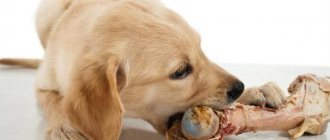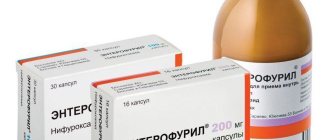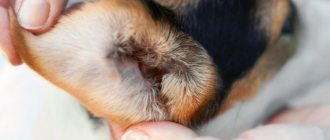How are dogs portrayed in cartoons and books? Here is the watchdog, and here is his bone, which he gnaws, taking breaks only for sleep and rest. But in reality, bones are not the best “treat” for these animals. Firstly, they have “0” nutritional value. Full. Secondly, when a dog has a bone stuck (even in its mouth) in the organs of the digestive system, its life will be in serious danger.
Killer treat
Sugar bone is the number one dog delicacy. This deep-rooted misconception is persistently refuted by life. Even wolves, the predatory ancestors of man’s barking companions, leave behind “horns and legs” from the prey they eat.
What can we say about a domestic dog that is accustomed to industrial food or delicate “human” food? A bone can turn into a lethal weapon for her. Such a “delicacy” can injure the throat, lead to organ ruptures, lose teeth, and cause suffocation.
What objects are most often swallowed by dogs?
Most often, a dog swallows foreign bodies while walking, so it is recommended not to leave it alone and watch what it picks up from the ground. At home, it is recommended to keep all dangerous objects that the animal may accidentally swallow out of reach. These simple rules will help you avoid dangerous situations.
Items commonly swallowed by dogs:
- socks,
- rubber balls,
- plastic bags,
- stones,
- hair bands,
- bones,
- sticks,
- yarn and threads,
- Christmas tinsel,
- coins,
- hairpins, etc.
Veterinarians recommend carefully monitoring products that are used for preparing meat dishes, and therefore are imbued with the taste and smell of meat (sticks, baking bags, foil forms, etc.).
How to recognize trouble?
If your dog has something stuck in his throat, a number of signs will help you notice that something is wrong:
- excessive salivation;
- cough with gagging, turning into wheezing;
- difficulty swallowing;
- inability to drink and eat;
- stretching the neck, shaking the head, touching the paws to the mouth;
- inability to take a breath;
- blueness of mucous membranes;
- panic, plaintive squeal;
- weakness in the legs;
- fainting state.
It also happens that a piece of bone does not get stuck in the dog’s throat, but passes into the larynx and “settles” there. Then events will develop according to a different scenario. Instead of these symptoms, the animal will simply “go on a hunger strike.” It will be extremely difficult to detect a chicken or rabbit bone on an x-ray: their density is identical to the cartilage tissue of a dog. You will have to rely only on the experience and professionalism of the doctor.
Bones are dangerous, useless and useful
Particularly “good” in this regard chicken bones left over from grilled chicken, caught from soup, etc. That is, those that have undergone heat treatment. They become extremely fragile, and at the same time easily split into long and sharp fragments. Each of them can easily pierce the esophagus, stomach or intestines. Even in the mouth, such pieces can cause a lot of trouble.
Fish bones are a real killing tool. Never, under any circumstances, feed them to dogs! They cause intestinal blockage and puncture and puncture internal organs. Very often, after such a “feast,” dogs have to be operated on or completely euthanized.
Perhaps the “safest” ones are boiled beef and pork . True, their nutritional value is no more than that of sawdust. But even this variety has a tendency to split, so care should be taken in any case.
Emergency help at home
What should you do if your dog has a bone stuck in its throat? First of all, you need to carefully examine the victim: sit him down in front of you, pull his head back by the scruff of the neck and look into the mouth, illuminating it with a flashlight. An examination of an aggressive animal is carried out using a special device - an oral speculum. Then they act according to the circumstances.
If your dog is choking and coughing
In this situation, there is no need to “slap the fever”: you need to let the animal’s body help itself. Coughing is a defensive reaction that is aimed at clearing the respiratory passages with a strong air stream. In the absence of a positive outcome, human participation will be required. You can help your pet in the following ways:
- shake the little dog slightly, bending his head down and pressing on the sternum;
- Take a large pet by the hind legs and hold it in this position for a couple of minutes.
The foreign object should push towards the exit and jump out with another sharp exhalation. However, keep in mind: dogs don't cough just because they have a bone stuck in their throat. The cause of anxiety syndrome may be one of the following pathologies:
- Rabies, which is accompanied not only by coughing, but also by shortness of breath, salivation, and refusal to eat. Later, the depressed state is aggravated by photophobia and paralysis of the limbs. In order not to become infected with a deadly disease, contact with a dog with these signs is strictly prohibited. It is necessary to call emergency veterinary workers.
- An adenovirus infection, the main symptom of which is kennel cough - dry, hysterical and painful. The disease most often occurs from hypothermia: inhaling frosty air or greedily eating unheated food from the refrigerator.
- Heart problems that make themselves felt by obsessive coughing, as if the animal is trying to get rid of a foreign object stuck in the throat. This is observed with increased size of the heart muscle or oxygen starvation. There are no signs of sudden asphyxia in these pathologies.
- Anatomical features of the mouth cavity with a “soft” palate in dwarf or short-faced pets. With such an anomaly, a hasty sip or inhalation can lead to retraction of the palatal tissues into the larynx. The problem resolves itself within a minute.
Do not try to induce vomiting in a choking dog. A large bone will not come out using this folk method. And small fragments, forcefully pushed out by vomit, can injure the esophagus.
If your dog is choking and can't clear his throat
In a situation where a four-legged animal is unable to inhale or exhale, you should act quickly and decisively. The Heimlich maneuver is considered an effective measure in veterinary practice. It has been practiced since the end of the last century to save choking animals from suffocation.
If a large dog chokes on a bone, the owner will have to get down on all fours next to it and grab its body. Hands should be on the dog’s stomach: one clenches into a fist and touches the sternum with the thumb; the other covers it from above with her palm. With sharp pressure from both hands, 4-5 subdiaphragmatic pushes are made in the direction of the larynx. Then the dog's mouth is examined, and the bone that appears in the throat is removed with surgical tweezers.
If a problem arises in a small dog, you need to press him with his back, tilt the dog’s head down with one hand, clench the other into a fist and place it on the sternum under the diaphragm. Then quickly make 4-5 sharp presses.
If breathing has been restored, but the dog is wheezing and the bone is not visible in the throat, there is only one way out: go to the veterinary clinic without delay. This will prevent the worst thing from moving deeper into the bone. This turn of events is fraught with a bunch of serious risks: from breaking through the tracheal wall to intestinal obstruction.
If a dog chokes on a fish bone
This is the most familiar situation for pet dog owners. It does not threaten suffocation: the foreign body in this case is so thin that it physically cannot block the airways. But a needle-like bone stuck in the throat can cause a lot of problems. The animal is doomed to excruciating acute pain, forced hunger, insomnia, and depression.
Removing a stuck fish bone at home is not difficult if it is in sight - on the back wall of the throat. It is necessary, armed with tweezers 10-15 cm long, to pry the piercing object, hold it tightly and quickly pull it out.
You should not offer your dog to swallow a bread crumb or crust in order to push through a fish bone. With the help of solid food, it can penetrate even deeper into the wall of the pharynx or break, turning into a microscopic splinter. In both cases, the work of the veterinarian, to whom the victim will have to be taken, will be greatly complicated.
If a fish bone is stuck
In general, a fish bone stuck in a dog's esophagus or throat does not pose any particular danger to the dog, unless it is a very large bone. Yes, it will bother the dog, but over time it can resolve on its own.
Of course, if it has stuck into the dog’s mouth or shallowly into the throat tissue, it must be removed independently using the methods already listed. It’s even better to feed the dog food that has enveloping properties for several days, such as semolina, oatmeal or rice boiled until sticky.
As it passes down the throat, such food can also drag along a fish bone. This method may not help, and if the dog’s condition worsens, you should take him to a veterinary hospital, where the fish bone will be quickly and easily removed.
Life without risk factors
Seeing a four-legged pet wheeze and suffocate is unbearable. The simplest preventive measures will help prevent misfortune:
- exclusion of any bones from the pet’s diet;
- prohibition of vagrancy, which is fraught with the search for “prey” in the form of inedible and dangerous foreign bodies.
Remember, bones are a cheap product that can cost you a lot. Block his path to the dog bowl forever - and he will not know grief. Pamper your pet with safe chewable treats from the pet store.
What treatment is prescribed by the veterinarian in the postoperative period?
After surgery, your pet will need more attention and special care. Each dog's postoperative period is different, so each of them needs an individual approach.
It should be remembered that postoperative therapy includes more than just injections. It also includes:
- daily walks;
- physical activity recommended by a veterinarian;
- proper nutrition.
Of the medications in the postoperative period, the veterinarian prescribes:
- painkilling injections intramuscularly;
- anti-inflammatory drugs;
- vitamins to strengthen your pet’s body:
- hydrochloric acid solution of Apomorphine.
Diagnostics
An appointment with a veterinarian begins with an examination of the pet. Often, long objects (for example, ropes) are wound around the root of the tongue, so they can be immediately removed from the mouth, preventing further consequences.
Otherwise, in order to determine whether a dog has swallowed a foreign object and in which part it is located, the following methods are used:
- X-ray examination . An X-ray can reveal abnormal expansion, which indicates the presence of foreign objects in the digestive system, but only if they are radiopaque (for example, metal or wood). It is much more difficult to identify polyethylene or rubber products.
- Ultrasonography . It allows you to identify obstruction caused by external factors. Using an ultrasound machine, it is possible to determine the movement of a foreign body if the motor functions of the intestines and digestive system are completely preserved.
- Esophagogastroscopy . This is the most objective diagnostic method, allowing you to determine not only the presence of a foreign body, but also the consequences to which it led. Additionally, esophagogastroscopy helps to assess the condition of the mucous membranes in order, if necessary, to prescribe treatment to restore them.
Only after diagnosis, a veterinarian in Moscow prescribes treatment. It is selected individually for each pet, because it largely depends on its general condition and degree of dehydration.
Choking hazard
Choking is dangerous in any case. Oxygen starvation and its associated consequences are dangerous to the dog’s health. Failure to properly provide first aid can lead to the death of your pet (contacting a veterinary clinic may not be timely).
Note! If your dog chokes and swallows an object, you should contact your veterinarian. Some items will have to be removed through surgery.
An animal can not only choke, but also swallow an object
General forecast
In more than 85% of cases the prognosis is favorable. It will be possible to remove the foreign object and restore the pet’s general well-being without consequences, if the presence of the foreign body does not lead to complete obstruction.
However, the specific forecast depends on the following factors:
- location of the foreign body after ingestion by the dog (in the stomach, esophagus, respiratory tract, etc.),
- size and shape of the object (blunt or with sharp edges, small or large, made of metal, plastic, etc.),
- general condition and age of the pet,
- the presence of complications that are already caused by ingestion of a foreign body.
Remember that the sooner you seek veterinary help, the higher your pet's chances of a full recovery. If you delay a visit to the doctor, complications may develop (intestinal damage, internal bleeding, peritonitis, soft tissue necrosis, etc.).
Prevention
Prevention consists of paying close attention to your pets. Develop a diet according to your doctor’s recommendations. Do not allow consumption of “random” food, limit walking in dangerous places that are located near garbage containers or landfills. The key to a pet’s health is care and attention, a timely response to the animal’s suspicious behavior.
Your dog's diet should be discussed with your veterinarian.
Main signs of suffocation
It can be difficult for beginners to identify the first signs of choking in a dog. However, it is important to become aware of such symptoms as early as possible. Main features:
- the dog’s breathing becomes heavy, “gurgling” and wheezing are possible;
- the pet begins to cough;
- Possible excessive salivation;
- the dog sometimes begins to feel sick and vomit;
- the dog holds its head down, restless behavior.
Sometimes the mucous membrane of the mouth acquires a bluish tint - this is the first sign of a lack of oxygen in the pet’s blood.
Your pet may become very nauseous when trying to get rid of a stuck object.
Important! Signs may vary depending on the size of the item. Large ones often cause a gag reflex, small ones cause pain, the dog begins to whine and wipe his face with his paw.











